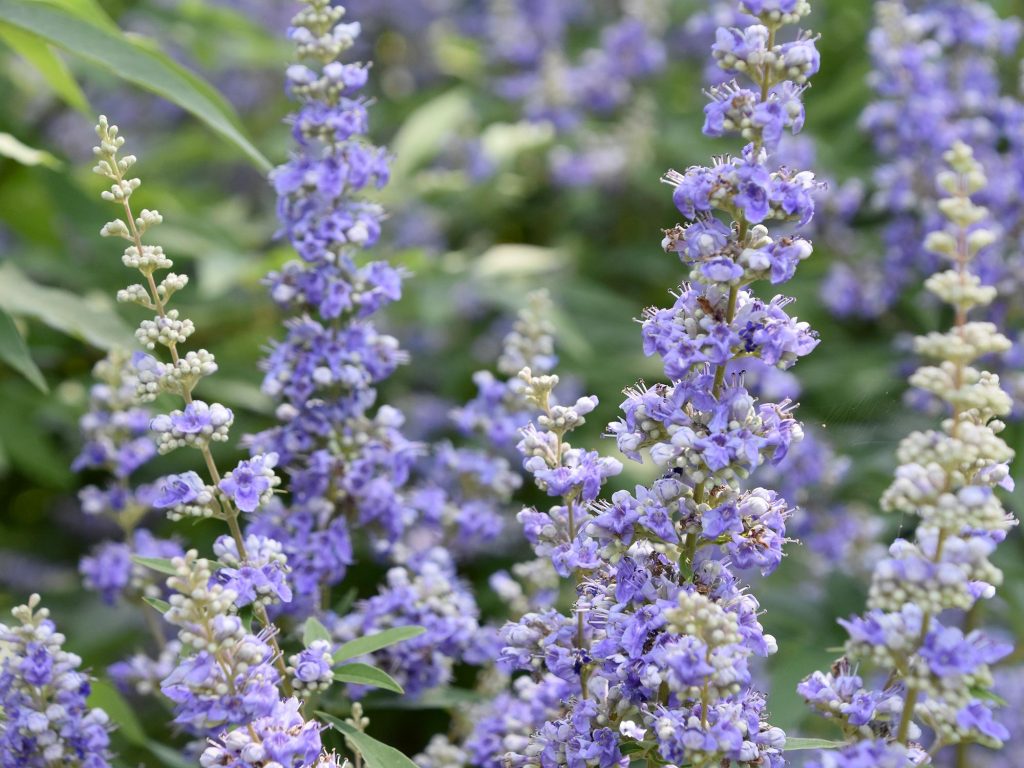
Vitex is an outstanding small tree for Mississippi landscapes. It can be grown as a single trunked tree or a multi-trunk specimen. (Photo by MSU Extension/Gary Bachman)

In 2002, vitex, also called the chaste tree, was named a Mississippi Medallion winner. Vitex is an eye catching specimen in the landscape. The flowers, called spikes, are composed of many clusters of small, individual flowers. In some varieties, these spikes can be up to eighteen inches long. Flower color varies from lavender to lilac and pale violet. The color can even be a brilliant, fluorescent blue.
During the initial blooming period the tree resembles a cloud of lilac emitting a delicate, slightly peppery scent. Butterflies are drawn to the plant in droves during the flowering season, and songbirds feast on the fruit clusters that appear in late summer.
Colors and Varieties
V. agnus-castus originates from southern Europe and western Asia and has since naturalized throughout Europe and the southern United States. Several cultivars of chaste tree are widely sold:
- V. agnus-castus ‘Shoal Creek’: A common variety, this chaste tree reaches 10 to 15 feet tall and 4 to 12 feet wide. It bears large, blue-violet flowers.
- V. agnus-castus ‘Abbeville Blue’:grows 6 feet tall with a similar spread; it has deep blue flowers on 12- to 18-inch spikes.
- V. agnus-castus ‘Alba’: white flowers; growing to 15 feet with a 20-foot spread.
- V. agnus-castus ‘Shoal Creek‘: a 15-foot-tall plant with purple-blue flowers and leaves that have good resistance to fungal spots.
- V. agnus-castus ‘Blue Puffball’: growing only 3 feet tall with delicate blue flowers.
- V. agnus-castus ‘Rosa Ann’: a 15-foot plant with heavily scented pink flowers.
- V. agnus-castus ‘Rosea’: another pink-flowered cultivar, growing to 15 feet.
Vitex agnus-castus is grown in zones 6 to 9; it is technically hardy down to about -9 degrees.
Growth Habits
The average lifespan is 15 to 20 years, but in ideal conditions, these plants sometimes live as many as forty years. If your chaste tree fails to bloom as robustly as you expect, it is likely because the plant is not getting enough sunlight. Another hindrance is excessive fertilizer. In most soils, this plant will require no additional feeding; fertilizer sometimes reduces flowering by stimulating green growth at the expense of blossoms. After pollination, the flowers give way to small, dark, peppercorn-like drupes in fall, each containing one to four seeds.
Soil Preferences
While it tolerates a wide variety of soil conditions and textures, make sure the planting bed has a well-drained soil.
Planting Depth & Spacing
Plant Vitex trees in the fall between September and December. Plant your vitex in full sun for the best flowering performance. The tree will tolerate part-sun but will not flower as heavily. Plant chaste trees as a single specimen on the lawn, in a row along a property line or driveway, as a small patio tree, or on a border with lower plants growing beneath it.

Watering
Water the chaste tree initially, but once it is established, water is not needed outside of prolonged drought.
Fertilizing
Fertilize every other year or so in the spring.
Pruning
Vitex tolerates a wide range of pruning styles. It can be easily maintained as an 8- to 10-foot small tree. Pruning promotes more compact branching, resulting in a thicker, bushier plant. Left unpruned, chaste trees can become a sprawling, vase-shaped shrub that sometimes grows to twenty feet or more with a spread equally as wide. You can train it as a single-trunk small tree by pruning away competing shoots to encourage a central leader.
Early pruning during winter will help keep the shrub in an attractive shape and control its size. Chaste trees tolerate heavy pruning quite well. In colder climates, this plant is pruned down to the ground just before winter. Because it flowers on new wood, your chaste tree will return to a 3- to 5-foot flowering shrub each year, even with this fierce pruning routine.
Since vitex flowers on new wood, which is the current season’s growth, pruning encourages flowering. Deadheading chaste tree flowers is a great idea, as peak bloom periods will repeat themselves if spent flowers are removed.
Pests
Chaste trees are pest-free, but thrip, aphids, whiteflies, and scales occasionally attack—control pests by spraying the tree with a hose in the morning or using insecticidal soap. Do not leave foliage wet. Soggy ground conditions promote other fungal infections like root rot and leaf spots.
Propagation
You can propagate through seeds or cuttings.
The summer fruits can stain pavement or lawn furniture. There is prolific self-seeding; volunteer plants will need to be pulled (and shared) to keep them from spreading.




